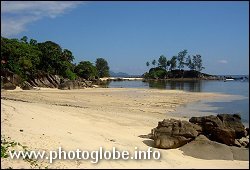| Earth from Space is a free eBook describing our planet from a satellite's perspective. Fore more information, please read the About pages. |

|

Home  Africa Africa  Seychelles Seychelles  Mahé Mahé |
|






|
|
Island of MahéPosition of center of photo (Lat/Long): [-4.680556/55.481667] |
|
  The Seychelles archipelago consists of 115 islands and thirty prominent rock formations scattered throughout a self-proclaimed exclusive economic zone of more than 1.35 million square kilometers of ocean. Some forty islands are granitic and lie in a ninety-kilometer radius from Mahé, the main island (see photo above). The remaining islands are coralline, stretching over a 1,200-kilometer radius from Île aux Vaches in the northeast to the Aldabra Atoll in the southwest. Mahé is twenty-five kilometers long and no more than eight kilometers wide. It contains the capital and only city, Victoria, an excellent port. Victoria lies approximately 1,600 kilometers east of Mombasa, Kenya; 2,800 kilometers southwest of Mumbai (Bombay), India; 1,700 kilometers north of Mauritius; and 920 kilometers northeast of Madagascar. The only other important islands by virtue of their size and population are Praslin and La Digue, situated about thirty kilometers to the northeast of Mahé. The Seychelles archipelago consists of 115 islands and thirty prominent rock formations scattered throughout a self-proclaimed exclusive economic zone of more than 1.35 million square kilometers of ocean. Some forty islands are granitic and lie in a ninety-kilometer radius from Mahé, the main island (see photo above). The remaining islands are coralline, stretching over a 1,200-kilometer radius from Île aux Vaches in the northeast to the Aldabra Atoll in the southwest. Mahé is twenty-five kilometers long and no more than eight kilometers wide. It contains the capital and only city, Victoria, an excellent port. Victoria lies approximately 1,600 kilometers east of Mombasa, Kenya; 2,800 kilometers southwest of Mumbai (Bombay), India; 1,700 kilometers north of Mauritius; and 920 kilometers northeast of Madagascar. The only other important islands by virtue of their size and population are Praslin and La Digue, situated about thirty kilometers to the northeast of Mahé.
The granitic islands are the peaks of the submarine Mascarene Plateau, a continental formation theorized to be either a part of Africa separated when Asia began to drift away from the original single continent of Gondwanaland, or the remnants of a microcontinent that existed up to the beginning of the Tertiary Period, approximately 50 million years ago. The granitic islands are characterized by boulder-covered hills and mountains as high as 940 meters rising abruptly from the sea. Elsewhere, narrow coastal plains extend to the base of the foothills. Extensively developed coral reefs are found mainly on the east coasts because of the southwest trade winds and equatorial current. Ninety-nine percent of the population is located on the granitic islands, and most are on Mahé. The coralline islands differ sharply from the granitic in that they are very flat, often rising only a few feet above sea level. They have no fresh water, and very few have a resident population. Many, like Île aux Vaches, Île Denis, the Amirante Isles, Platte Island, and Coetivy Island are sand cays upon which extensive coconut plantations have been established. Some of the coralline islands consist of uplifted reefs and atolls covered with stunted vegetation. Several of these islands have been important breeding grounds for turtles and birds, as well as the sites of extensive guano deposits, which formerly constituted an important element of the Seychellois economy but now for the most part are depleted. Aldabra Islands, the largest coralline atoll with an area greater than Mahé, is a sanctuary for rare animals and birds.
|
| Source of material: Photo: NASA, Text: Country Studies Seychelles |
Further information: WikiPedia article on Island of Mahé
Last Update: 2011-03-30


